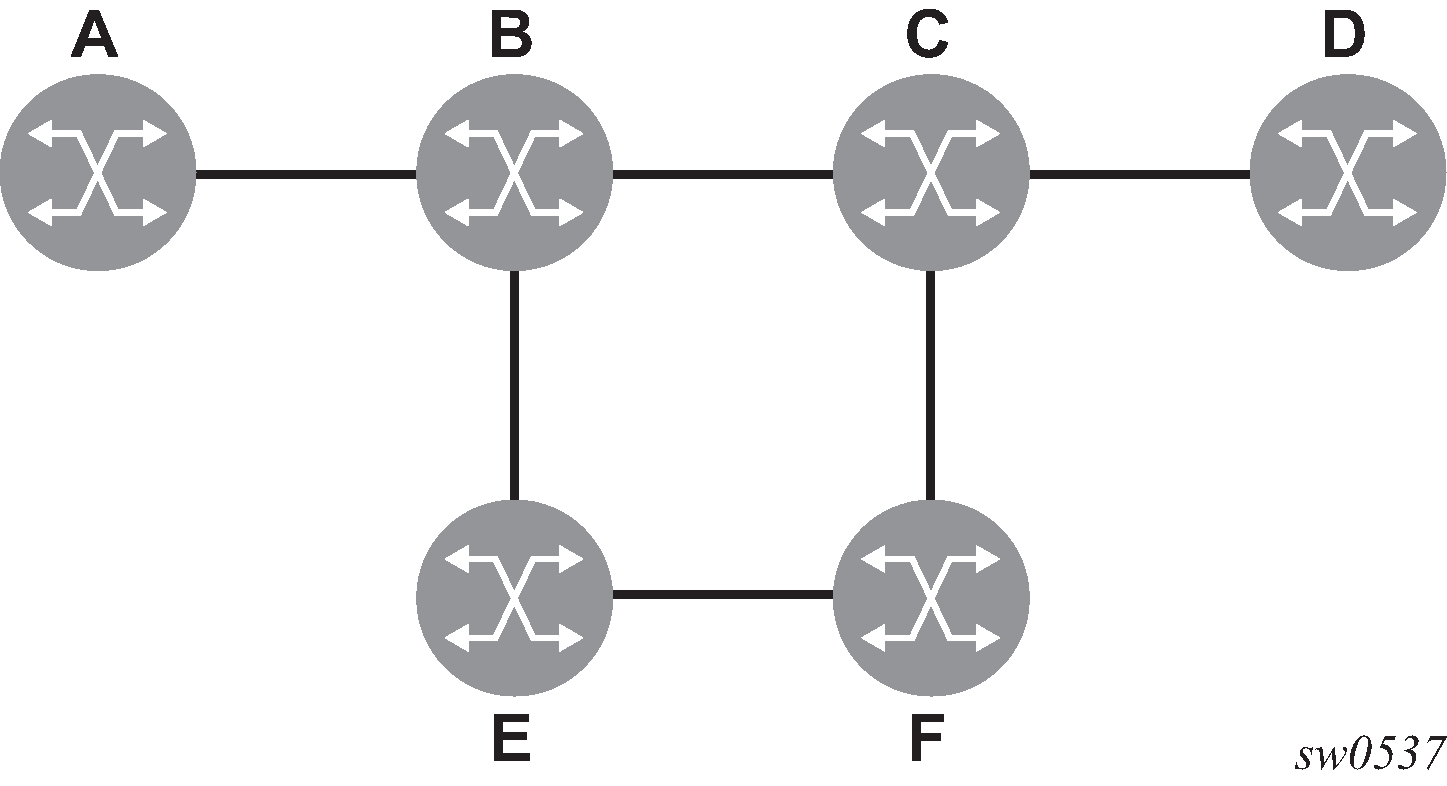The following figure shows bypass tunnel nodes.

The PLR uses the following rules to select a bypass LSP among multiple manual and dynamic bypass LSPs at the time of establishment of the primary LSP path or when searching for a bypass for a protected LSP which does not have an association with a bypass tunnel:
The MPLS/RSVP task in the PLR node checks if an existing manual bypass satisfies the constraints. If the path message for the primary LSP path indicated node protection is needed, which is the default LSP FRR setting at the head end node, MPLS/RSVP task searches for a node-protect' bypass LSP. If the path message for the primary LSP path indicated link protection is needed, then it searches for a link-protect bypass LSP.
If multiple manual bypass LSPs satisfying the path constraints exist, it will prefer a manual-bypass terminating closer to the PLR over a manual bypass terminating further away. If multiple manual bypass LSPs satisfying the path constraints terminate on the same downstream node, it selects one with the lowest IGP path cost or if in a tie, picks the first one available.
If none satisfies the constraints and dynamic bypass tunnels have not been disabled on PLR node, then the MPLS/RSVP task in the PLR will check if any of the already established dynamic bypasses of the requested type satisfies the constraints.
If none do, then the MPLS/RSVP task will ask CSPF to check if a new dynamic bypass of the requested type, node-protect or link-protect, can be established.
If the path message for the primary LSP path indicated node protection is needed, and no manual bypass was found after Step 1, or no dynamic bypass LSP was found after 3 attempts of performing Step 3, the MPLS/RSVP task will repeat Steps 1-3 looking for a suitable link-protect bypass LSP. If none are found, the primary LSP will have no protection and the PLR node must clear the "local protection available" flag in the IPv4 address sub-object of the record route object (RRO) starting in the next Resv refresh message it sends upstream.
If the path message for the primary LSP path indicated link protection is needed, and no manual bypass was found after step 1, or no dynamic bypass LSP was found after performing Step 3, the primary LSP will have no protection and the PLR node must clear the "local protection available" flag in the IPv4 address sub-object of the RRO starting in the next RESV refresh message it sends upstream. The PLR will not search for a node-protect’ bypass LSP in this case.
If the PLR node successfully makes an association, it must set the "local protection available" flag in the IPv4 address sub-object of the RRO starting in the next RESV refresh message it sends upstream.
For all primary LSP that requested FRR protection but are not currently associated with a bypass tunnel, the PLR node on reception of RESV refresh on the primary LSP path repeats Steps 1-7.
If the user disables dynamic-bypass tunnels on a node while dynamic bypass tunnels were activated and were passing traffic, traffic loss will occur on the protected LSP. Furthermore, if no manual bypass exist that satisfy the constraints of the protected LSP, the LSP will remain without protection.
If the user configures a bypass tunnel on node B and dynamic bypass tunnels have been disabled, LSPs which have been previously signaled and which were not associated with any manual bypass tunnel, for example, none existed, will be associated with the manual bypass tunnel if suitable. The node checks for the availability of a suitable bypass tunnel for each of the outstanding LSPs every time a RESV message is received for these LSPs.
If the user configures a bypass tunnel on node B and dynamic bypass tunnels have not been disabled, LSPs which have been previously signaled over dynamic bypass tunnels will not automatically be switched into the manual bypass tunnel even if the manual bypass is a more optimized path. The user will have to perform a make before break at the head end of these LSPs.
If the manual bypass goes into the down state in node B and dynamic bypass tunnels have been disabled, node B (PLR) will clear the "protection available" flag in the RRO IPv4 sub-object in the next RESV refresh message for each affected LSP. It will then try to associate each of these LSPs with one of the manual bypass tunnels that are still up. If it finds one, it will make the association and set again the "protection available" flag in the next RESV refresh message for each of these LSPs. If it could not find one, it will keep checking for one every time a RESV message is received for each of the remaining LSPs. When the manual bypass tunnel is back UP, the LSPs which did not find a match will be associated back to this tunnel and the protection available flag is set starting in the next RESV refresh message.
If the manual bypass goes into the down state in node B and dynamic bypass tunnels have not been disabled, node B will automatically signal a dynamic bypass to protect the LSPs if a suitable one does not exist. Similarly, if an LSP is signaled while the manual bypass is in the down state, the node will only signal a dynamic bypass tunnel if the user has not disabled dynamic tunnels. When the manual bypass tunnel is back into the UP state, the node will not switch the protected LSPs from the dynamic bypass tunnel into the manual bypass tunnel.